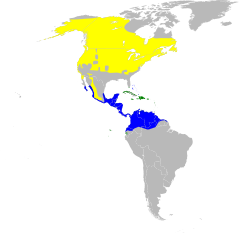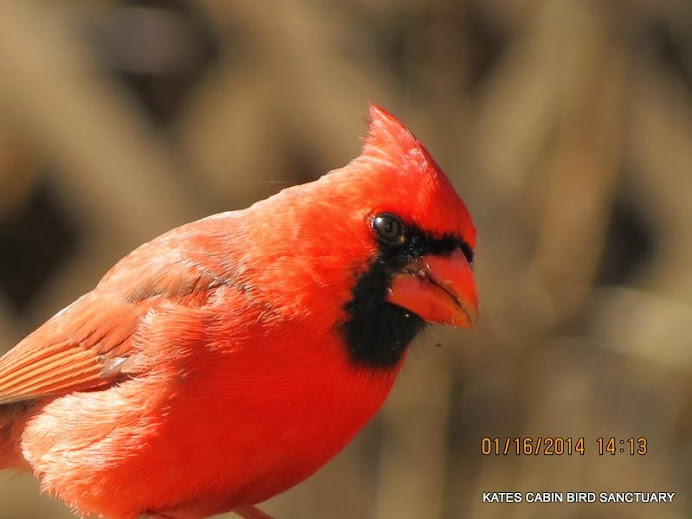
Hi Everybody!!
Be glad you can not hear me singing! However, the birds in tonight's post and the album photostudies can sing beautifully. You might ask: Why is a songbird different than all other birds? It just so happens the answer is below in the Wikipedia info excerpt. Also, the links to the songbird albums on G+ are listed. I thought about all of You that may not be able to see birds up close. These guys let me sit among them now as they feed. So, I snapped a few shots so you could see them enjoying their seed snacks. The cardinals look over the little birds fondly. Soon the little ones will go back up north. The cardinals stay year round and will start having babies within weeks. Looks like it will be a great year for birding. Prepare to enjoy the moments!

created by G+Auto Backup

https://en.wikipedia.org/wiki/Songbird
Songbird
From Wikipedia, the free encyclopedia
A songbird is a bird belonging to the clade Passeri of the perching birds (Passeriformes). Another name that is sometimes seen as scientific or vernacular name is Oscines, from Latin oscen, "a songbird". This group contains some 4,000 species found all over the world, in which the vocal organ typically is developed in such a way as to produce a diverse and elaborate bird song.
Songbirds form one of the two major lineages of extant perching birds, the other being the Tyranni which are most diverse in the Neotropics and absent from many parts of the world. These have a simpler syrinx musculature, and while their vocalizations are often just as complex and striking as those of songbirds, they are altogether more mechanical sounding. There is a third perching bird lineage, the Acanthisitti from New Zealand, of which only two species remain alive today.[1]
There is evidence to suggest that songbirds evolved 50 million years ago in the part ofGondwana that later became Australia, New Zealand, New Guinea and Antarctica, before spreading around the world.[citation needed]
| Songbirds | |
|---|---|
 | |
| Eastern Yellow Robin (Eopsaltria australis) | |
| Song of a Chipping Sparrow (Spizella passerina) | |
| Scientific classification | |
| Kingdom: | Animalia |
| Phylum: | Chordata |
| Class: | Aves |
| Order: | Passeriformes |
| Suborder: | Passeri |
Description[edit]
The song in this clade is essentially territorial in that it communicates the identity and whereabouts of an individual to other birds and also signals sexual intentions. It is not to be confused with bird calls which are used for alarms and contact and are especially important in birds that feed or migrate in flocks. While almost all living birds give calls of some sort, well-developed songs are only given by a few lineages outside the songbirds.
Other birds (especially non-passeriforms) sometimes have songs to attract mates or hold territory, but these are usually simple and repetitive, lacking the variety of many oscine songs. The monotonous repetition of the Common Cuckoo or Little Crake can be contrasted with the variety of a Nightingale or Marsh Warbler. On the other hand, although many songbirds have songs which are pleasant to the human ear, this is not invariably the case. Many members of the crow family (Corvidae) communicate with croaks or screeches which sound harsh to humans. Even these, however, have a song of sorts, a softer twitter which is given between courting partners. And even though some parrots (which are not songbirds) can be taught to repeat human speech, vocal mimicry among birds is almost completely restricted to songbirds, some of which (such as the lyrebirds or the aptly-named mockingbirds) excel in imitating the sounds of other birds or even environmental noises.

American Goldfinch - Wikipedia, the free encyclopedia
en.wikipedia.org/wiki/American_Goldfinch
| American Goldfinch | |
|---|---|
 | |
| Male American Goldfinch in winter plumage | |
| Conservation status | |
| Scientific classification | |
| Kingdom: | Animalia |
| Phylum: | Chordata |
| Class: | Aves |
| Order: | Passeriformes |
| Family: | Fringillidae |
| Genus: | Carduelis |
| Species: | C. tristis |
| Binomial name | |
| Carduelis tristis (Linnaeus, 1758) | |
| Subspecies | |
| |
 | |
| Breeding range Year-round range Wintering range | |
male cardinal above
Northern Cardinal - Wikipedia, the free encyclopedia
en.wikipedia.org/wiki/Northern_Cardinal
Taxonomy - Description - Distribution and habitat - Ecology
| Northern Cardinal | |
|---|---|
 | |
| Male in Ohio, USA | |
 | |
| Female in Florida, USA | |
| Conservation status | |
| Scientific classification | |
| Kingdom: | Animalia |
| Phylum: | Chordata |
| Class: | Aves |
| Order: | Passeriformes |
| Family: | Cardinalidae |
| Genus: | Cardinalis |
| Species: | C. cardinalis |
| Binomial name | |
| Cardinalis cardinalis (Linnaeus, 1758) | |
 | |
| Range of C. cardinalis | |

Chipping Sparrow:

Chipping Sparrow - Wikipedia, the free encyclopedia
en.wikipedia.org/wiki/Chipping_Sparrow
The Chipping Sparrow (Spizella passerina) is a species of American sparrow in the family Emberizidae. It is widespread, fairly tame, and common across most of...
| Chipping Sparrow | |
|---|---|
 | |
| Adult in breeding plumage | |
| Conservation status | |
| Scientific classification | |
| Kingdom: | Animalia |
| Phylum: | Chordata |
| Class: | Aves |
| Subclass: | Neornithes |
| Infraclass: | Neognathae |
| Superorder: | Neoaves |
| Order: | Passeriformes |
| Suborder: | Passeri |
| Infraorder: | Passerida |
| Superfamily: | Passeroidea |
| Family: | Emberizidae |
| Genus: | Spizella |
| Species: | S. passerina |

Yellow Warbler:

American Yellow Warbler - Wikipedia, the free encyclopedia
en.wikipedia.org/wiki/American_Yellow_Warbler
The American Yellow Warbler (Setophaga petechia, formerly Dendroica petechia) is a New World warbler species. Sensu lato, they make up the most ... American Yellow Warbler 
Male in breeding plumage, Canada Conservation status Scientific classification Kingdom: Animalia Phylum: Chordata Class: Aves Order: Passeriformes Family: Parulidae Genus: Setophaga Species: S. petechia Binomial name Setophaga petechia
(Linnaeus, 1766)Subspecies About 35 (but see text)
Distribution of the Yellow Warbler Breeding range Year-round range Wintering range
- en.wikipedia.org/wiki/Tufted_Titmouse
The Tufted Titmouse (Baeolophus bicolor) is a small songbird from North America, a species in the tit and chickadee family (Paridae). The Black-crested ...
| Tufted Titmouse | |
|---|---|
 | |
| Johnston County, North Carolina | |
| Conservation status | |
| Scientific classification | |
| Kingdom: | Animalia |
| Phylum: | Chordata |
| Class: | Aves |
| Subclass: | Neornithes |
| Infraclass: | Neognathae |
| Superorder: | Neoaves |
| Order: | Passeriformes |
| Suborder: | Passeri |
| Infraorder: | Passerida |
| Family: | Paridae |
| Genus: | Baeolophus |
| Species: | B. bicolor |
| Binomial name | |
| Baeolophus bicolor (Linnaeus, 1766)[verification needed] | |
 | |
| Combined range of Tufted Titmouse and Black-crested Titmouse | |

**************************************
Links to Songbird Albums 2014:
https://plus.google.com/u/0/photos/117645114459863049265/albums/5969902802022577233
https://plus.google.com/u/0/photos/117645114459863049265/albums/5969913027377326881
https://plus.google.com/u/0/photos/117645114459863049265/albums/5969914597966442353
https://plus.google.com/u/0/photos/117645114459863049265/albums/5969918451750043137









...this is brendasue signing off from Rainbow Creek. See You next time! Remember to feed the birds


O+O





No comments:
Post a Comment
Hi Everybody! Please say hello and follow so I know you are here! Due to the inconsideration of people trying to put commercials on my blog comment area, I have restricted use of anonymous posts. Sorry that some hurt all.
My public email is katescabin@gmail.com No spammers or trolls